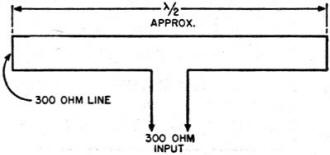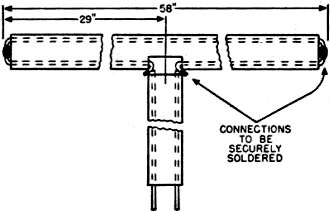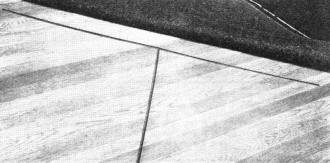|
April 1947 Radio News
 [Table of Contents] [Table of Contents]
Wax nostalgic about and learn from the history of early
electronics. See articles from
Radio & Television News, published 1919-1959. All copyrights hereby
acknowledged.
|
Folded dipole antennas, as the name
suggests, are about half the length of a regular dipole, and work just as well for
many applications. I have had one attached to my FM radio receiver for many years
and it does a great job pulling in stations from as far away as Toronto, Canada,
and Detroit, Michigan (from Erie, PA). Receiver sensitivity and oscillator
stability has been able to obviate the need in most cases for super performance
antennas in modern receivers, as evidenced by ear bud wires and even conformal patch
antennas in smartphones sufficing in lieu of a "real" antenna. It is a real tribute
to the brilliance of engineers that cellphones work so well on multiple bands that
accommodate frequencies ranging from 88 MHz (FM), through
900 MHz (GSM), 1.5 GHz (GPS), 2 GHz (UMTS),
and
WiFi (2.4 GHz) - all in one compact device with no external
antenna!
Folded Dipole FM and Television Antenna
New 300-ohm transmission line makes possible low-priced dipole antenna systems
for TV and FM.

Fig. 1 - Electrical representation of the FM and television
folded dipole antenna.

Fig. 2 - Mechanical details show how the 300·ohm transmission
line may be used.

This simple, low-cost 300·ohm line receiving antenna can be conveniently
placed under the rug.
A simple, low cost FM and television receiving antenna which is superior in performance
and easier to install than many of the more elaborate and expensive types can now
be constructed using the new 300 ohm lead-in wire K-1046, manufactured by Federal
Telephone and Radio Corporation. Requiring only between 5 and 10 feet (depending
on the frequency) of this inexpensive, highly flexible twin conductor transmission
line, this antenna is very efficient and provides a perfectly matched folded dipole
and lead-in for FM and television.
As indicated on Fig. 1 this antenna, a "T" match type, consists of a 300
ohm cable which is a half wavelength long, is shorted at both ends and has a one
conductor cut in the center as the input or lead-in point. The entire construction
takes between fifteen and twenty minutes and requires only three stripping and soldering
operations.
First the cable is shorted at both ends by stripping the insulation for a short
distance and twisting the two conductors together. Then they are soldered and an
insulating lacquer spread over them to weatherproof the connection. These shorted
ends also provide a means of supporting the antenna without affecting the characteristics
of the transmission line.
Then the lead-in is connected to the midpoint of one conductor. This operation
requires a little more caution since the width of the cut must exactly equal the
conductor spacing of the lead-in. The cut is made just clear of the inside of one
conductor exactly at the midpoint. Sufficient insulation is removed from the two
ends of the conductors thus provided so as to enable the lead-in to be connected
to them. The connections are soldered and lacquered and the assembly is now ready
for mounting.
The antenna is mounted by simply suspending it on an insulating material, such
as wood, using the two exposed short circuited ends as means of support. For maximum
signal pick-up the antenna should be as high off the ground as possible. However
when an outdoor antenna is either impractical (due to climatic conditions), or unnecessary,
the antenna - due to the flat ribbon construction of the 300 ohm line - can conveniently
be placed under the rug or behind a piece of furniture.
The antenna shown in Fig. 2 was designed for FM reception and is therefore
58 inches long. Since, as any folded dipole, it has an impedance of 300 ohms when
removed from ground, and since the conventional input impedance of a FM or television
set is 300 ohms, it provides a perfectly matched system.
The K-1046 is polyethylene insulated which makes it low loss, weather resisting,
and extremely flexible even in sub-zero climate. This cable retains an attractive
appearance since polyethylene is water repellent and therefore dries quickly and
remains clean.
Posted February 14, 2023
(updated from original
post on 9/1/2016)
|












